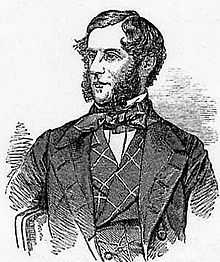John Sadleir

John Sadleir (1813 – 17 February 1856) was an Irish financier and politician.
He entered the House of Commons of the United Kingdom of Great Britain and Ireland in 1847 as a Member of Parliament for Carlow. Sadleir co-founded the Catholic Defence Association in 1851 and was one of the leading figures in the Independent Irish Party which held the balance of power in the House of Commons when it formed in 1852.[1]
He went on to hold minor office in Lord Aberdeen's coalition government from 1852 through 1854. He resigned his ministerial position in 1854 when he was found guilty of being implicated in a plot to imprison a depositor of the Tipperary Bank because the individual in question had refused to vote for him.
By February 1856 the Tipperary Bank was insolvent, owing to Sadleir's overdraft of £288,000. His own financial affairs were ruinous, and in his efforts to solve his problems he milked the London Bank, ruined a small Newcastle upon Tyne bank, sold forged shares of the Swedish Railway Company, raised money on forged deeds, and spent rents of properties he held in receivership and money entrusted to him as a solicitor. In this way he disposed of more than £1.5 million, mainly in disastrous speculations. Unable to face the consequences, he committed suicide near Jack Straw's Tavern on Hampstead Heath on 17 February 1856 by drinking prussic acid. The Times reported that "[t]he body of Mr J. Sadleir M.P. was found on Sunday morning, February 17th on Hampstead Heath, at a considerable distance from the public road. A large bottle labelled "Oil of Bitter Almonds" and a jug also containing the poison (prussic acid) lay by his side."[2] The body was identified by Edwin James QC MP and Thomas Wakley MP, editor of The Lancet. His brother James Sadleir, also an MP, was found to be deeply implicated in the fraud, having conspired with his younger brother. He was expelled from the House of Commons on 16 February 1857. He fled to the Continent, settling in Zurich and then Geneva. He was murdered there in 1881 while being robbed of his gold watch.
John Sadleir was buried in an unmarked grave in Highgate Cemetery.[1]
Legacy
Charles Dickens based the character of the great financier Mr. Merdle (who goes bankrupt and commits suicide) in Little Dorrit (1857) on John Sadleir. The central character of Anthony Trollope's The Way We Live Now (1875), Melmotte (also swindling financier who is bankrupt and commits suicide) may have been based on Sadleir, as well.[1] W. S. Gilbert based part of his 1869 play An Old Score on the story of Sadleir's suicide. Because the Independent Irish Party were pledged not to take office the decision of Sadleir and his friend William Keogh to do so was considered an unforgivable betrayal and " to be another Sadleir or Keogh" entered the Irish political vocabulary as synonymous with a political turncoat.
References
External links
| Parliament of the United Kingdom | ||
|---|---|---|
| Preceded by Brownlow Villiers Layard |
Member of Parliament for Carlow 1847–1853 |
Succeeded by John Alexander |
| Preceded by Charles Towneley |
Member of Parliament for Sligo Borough 1853–1856 |
Succeeded by John Wynne |
| Political offices | ||
| Preceded by Marquess of Chandos The Lord Henry Lennox Thomas Bateson |
Junior Lord of the Treasury 1853–1854 |
Succeeded by Chichester Fortescue |
|